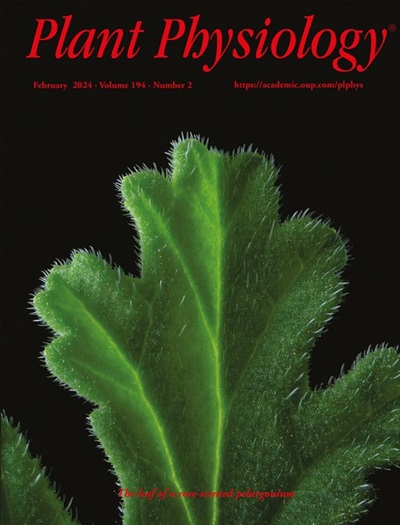Disrupted Nitric Oxide Homeostasis Impacts Fertility through Multiple Processes Including Protein Quality Control
IF 6.9
1区 生物学
Q1 PLANT SCIENCES
引用次数: 0
Abstract
Plant fertility is fundamental to plant survival and requires the coordinated interaction of developmental pathways and signaling molecules. Nitric oxide (NO) is a small, gaseous signaling molecule that plays crucial roles in plant fertility as well as other developmental processes and stress responses. NO influences biological processes through S-nitrosation, the posttranslational modification of protein cysteines to S-nitrosocysteine (R-SNO). NO homeostasis is controlled by S-nitrosoglutathione reductase (GSNOR), which reduces S-nitrosoglutathione (GSNO), the major form of NO in cells. GSNOR mutants (hot5-2/gsnor1) have defects in female gametophyte development along with elevated levels of reactive nitrogen species and R-SNOs. To better understand the fertility defects in hot5-2, we investigated the in vivo nitrosoproteome of Arabidopsis (Arabidopsis thaliana) floral tissues coupled with quantitative proteomics of pistils. To identify protein-SNOs, we used an organomercury-based method that involves direct reaction with S-nitrosocysteine, enabling specific identification of S-nitrosocysteine–containing peptides and S-nitrosated proteins. We identified 1102 endogenously S-nitrosated proteins in floral tissues, of which 1049 were unique to hot5-2. Among the identified proteins, 728 were novel S-nitrosation targets. Notably, specific UDP-glycosyltransferases and argonaute proteins are S-nitrosated in floral tissues and differentially regulated in pistils. We also discovered S-nitrosation of subunits of the 26S proteasome together with increased abundance of proteasomal components and enhanced trypsin-like proteasomal activity in hot5-2 pistils. Our data establish a method for nitrosoprotein detection in plants, expand knowledge of the plant S-nitrosoproteome, and suggest that nitro-oxidative modification and NO homeostasis are critical to protein quality control in reproductive tissues.一氧化氮平衡紊乱通过蛋白质质量控制等多个过程影响生育能力
植物生育力是植物生存的基础,需要发育途径和信号分子的协调互动。一氧化氮(NO)是一种小型气态信号分子,在植物生育以及其他发育过程和应激反应中发挥着至关重要的作用。一氧化氮通过 S-亚硝基化(蛋白质半胱氨酸翻译后修饰为 S-亚硝基半胱氨酸(R-SNO))影响生物过程。NO 的平衡由 S-亚硝基谷胱甘肽还原酶(GSNOR)控制,该酶还原 S-亚硝基谷胱甘肽(GSNO),这是细胞中 NO 的主要形式。GSNOR突变体(hot5-2/gsnor1)存在雌配子体发育缺陷,同时活性氮物种和R-SNOs水平升高。为了更好地了解 hot5-2 的生育缺陷,我们结合雌蕊的定量蛋白质组学研究了拟南芥(Arabidopsis thaliana)花组织的体内亚硝基蛋白质组。为了鉴定蛋白质-SNOs,我们使用了一种基于有机汞的方法,该方法涉及与 S-亚硝基半胱氨酸的直接反应,从而能够特异性鉴定含 S-亚硝基半胱氨酸的肽和 S-亚硝基化的蛋白质。我们在花卉组织中鉴定出了 1102 个内源性 S-亚硝酸盐化蛋白质,其中 1049 个是 hot5-2 特有的。在鉴定出的蛋白质中,有 728 个是新的 S-亚硝基化靶标。值得注意的是,特定的 UDP-糖基转移酶和 argonaute 蛋白在花组织中被 S-亚硝基化,并在雌蕊中受到不同程度的调控。我们还发现,在 hot5-2 雌蕊中,26S 蛋白酶体亚基发生了 S-亚硝基化,同时蛋白酶体成分的丰度增加,胰蛋白酶样蛋白酶体活性增强。我们的数据建立了一种植物亚硝基蛋白检测方法,扩大了对植物 S-亚硝基蛋白组的认识,并表明亚硝基氧化修饰和 NO 平衡对生殖组织中的蛋白质质量控制至关重要。
本文章由计算机程序翻译,如有差异,请以英文原文为准。
求助全文
约1分钟内获得全文
求助全文
来源期刊

Plant Physiology
生物-植物科学
CiteScore
12.20
自引率
5.40%
发文量
535
审稿时长
2.3 months
期刊介绍:
Plant Physiology® is a distinguished and highly respected journal with a rich history dating back to its establishment in 1926. It stands as a leading international publication in the field of plant biology, covering a comprehensive range of topics from the molecular and structural aspects of plant life to systems biology and ecophysiology. Recognized as the most highly cited journal in plant sciences, Plant Physiology® is a testament to its commitment to excellence and the dissemination of groundbreaking research.
As the official publication of the American Society of Plant Biologists, Plant Physiology® upholds rigorous peer-review standards, ensuring that the scientific community receives the highest quality research. The journal releases 12 issues annually, providing a steady stream of new findings and insights to its readership.
 求助内容:
求助内容: 应助结果提醒方式:
应助结果提醒方式:


